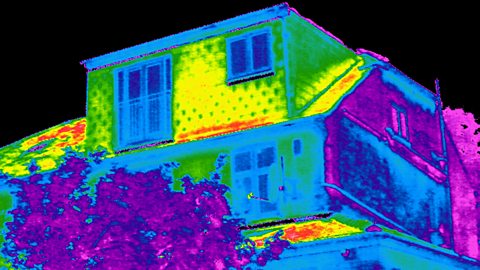Reducing heat transfers – houses
Heat energy is lost from buildings through their roofs, windows, walls, floors and through gaps around windows and doors.
However, there are ways that these losses can be reduced.
Heat escape routes
Take a look at this thermogramImage made by detecting infrared radiation rather than visible light. Different colours are used to represent the different temperatures of the objects in the image. of a house. The roof and windows are the hottest, showing that most heat is lost from the house through those parts.

Heat energy is transferred from homes by conductionThe transfer of heat through a material by transferring kinetic energy from one particle to another. through the walls, floor, roof and windows.
It is also transferred from homes by convectionThe transfer of heat energy through a moving liquid or gas..
For example, as hot air in rooms rise, cold air can enter the house through gaps in doors and windows to replace it.
These convection currents can transfer heat energy into the loft.
Heat energy also leaves the house by radiationEnergy carried by particles from a radioactive substance, or spreading out from a source. - through the walls, roof and windows.
Ways to reduce heat loss
Key point
Trapped air is a natural insulator and because it is trapped, convection currents cannot be set up easily. So, trapped air reduces heat loss by conduction and convection. Many insulating materials incorporate trapped air.
There are several different ways to reduce heat loss:
- Simple ways to reduce heat loss include fitting carpets, curtains and draught excluders. It is even possible to fit reflective foil behind radiators.
- Heat loss through windows can be reduced by using double glazing. These windows have dry, trapped air between two panes of glass. This reduces heat loss by conduction and convection. Air is a poor conductorA material which allows charge to move easily through it. and by trapping it between the panes, convection currents cannot be set up.
- Heat loss through walls can be reduced using cavity wall insulation. This involves blowing insulating material into the gap between the brick and the inside wall. Insulating materials are bad conductors and so this reduces the heat loss by conduction. The material also prevents air circulating inside the cavity, therefore reducing heat loss by convection.
- Heat loss through the roof can be reduced by laying loft insulation. Air is trapped between the fibres of the insulation, reducing heat loss by conduction.